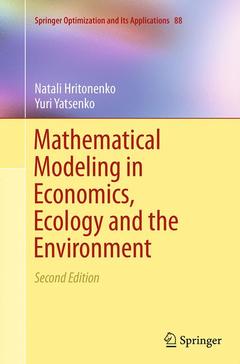Description
Mathematical Modeling in Economics, Ecology and the Environment (2nd Ed., Softcover reprint of the original 2nd ed. 2013)
Springer Optimization and Its Applications Series, Vol. 88
Authors: Hritonenko Natali, Yatsenko Yuri
Language: English
Subjects for Mathematical Modeling in Economics, Ecology and the...:
60.12 €
In Print (Delivery period: 15 days).
Add to cartPublication date: 08-2016
Support: Print on demand
Approximative price 84.39 €
In Print (Delivery period: 15 days).
Add to cartPublication date: 01-2014
296 p. · 15.5x23.5 cm · Hardback
Description
/li>Contents
/li>Biography
/li>Comment
/li>
Updated to textbook form by popular demand, this second edition discusses diverse mathematical models used in economics, ecology, and the environmental sciences with emphasis on control and optimization. It is intended for graduate and upper-undergraduate course use, however, applied mathematicians, industry practitioners, and a vast number of interdisciplinary academics will find the presentation highly useful.
Core topics of this text are:
· Economic growth and technological development
· Population dynamics and human impact on the environment
· Resource extraction and scarcity
· Air and water contamination
· Rational management of the economy and environment
· Climate change and global dynamics
The step-by-step approach taken is problem-based and easy to follow. The authors aptly demonstrate that the same models may be used to describe different economic and environmental processes and that similar investigation techniques are applicable to analyze variousmodels. Instructors will appreciate the substantial flexibility that this text allows while designing their own syllabus. Chapters are essentially self-contained and may be covered in full, in part, and in any order.
Appropriate one- and two-semester courses include, but are not limited to, Applied Mathematical Modeling, Mathematical Methods in Economics and Environment, Models of Biological Systems, Applied Optimization Models, and Environmental Models. Prerequisites for the courses are Calculus and, preferably, Differential Equations.
Natali Hritonenko is an award-winning professor of mathematics at Prairie View A&M University. She has traveled the world sharing her research results through numerous presentations and collaborating on groundbreaking research projects with a diverse team of leading experts. During her prolific career, Dr. Hritonenko has authored 7 books and well over 100 papers, and is also on the editorial board of 9 international interdisciplinary journals. Her real passion, however, is teaching and she aims to bring the fascinating and versatile nature of mathematics to her students, while also revealing to them the insights that mathematics can bring to any subject.
Dr. Yuri Yatsenko has published seven books and over 200 papers. He earned his MS and PhD from Kiev State University and a Doctor of Science from the USSR Academy of Sciences (Moscow). During his career, he has been a professor in five different countries and taught mathematics, statistics, economics, information systems, and computer sciences in four languages. For five years, he held senior positions in data analytics and operations research at international companies in USA and Canada. He joined Houston Baptist University in 2002 and is currently engaged in intensive collaboration with several European and Asian universities. His areas of expertise include modeling andoptimization of economic, industrial, and environmental processes, technological change, innovations, operations research, and computational methods.




